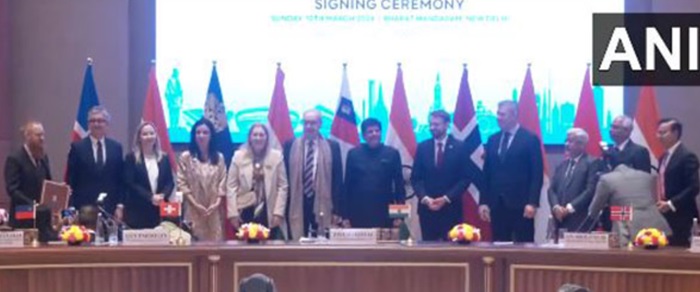
The India-EFTA signed Trade and Economic Partnership Agreement (TEPA) on 10th March 2024 marks a significant milestone in fostering trade relations between India and EFTA countries. This agreement signifies progression towards the signing of a Free Trade Agreement (FTA) with the European Union. EFTA is an important group of developed countries in Europe consisting of Liechtenstein, Iceland, Norway, and Switzerland. They formed this union in 1960 for the intensification of trade.
Negotiations commenced for the Trade and Economic Partnership Agreement (TEPA) between India and the EFTA countries in 2008. It took an extensive 21 rounds of negotiations, spanning nearly 16 years, before the final agreement was eventually signed by all parties involved.
This agreement holds significance as it represents the first-ever free trade agreement between India and European countries. However, its enforcement is contingent upon the ratification process, which requires all five countries – India, Liechtenstein, Iceland, Norway, and Switzerland – to ratify the agreement. Only after the instruments of ratification have been deposited with the government of Norway will the agreement come into force on the “first day of the third month.”
Currently, India’s merchandise trade with EFTA countries stands at USD 18.7 billion, with exports worth USD 1.9 billion and imports atUSD 16.7 billion, resulting in a trade deficit of USD 14.8 billion.
A country-wise trade direction reveals that out of four trading partners, Switzerland emerges as the dominant trade partner, accounting for 91% of bilateral merchandise trade.
Currently, India’s merchandise exports to Switzerland stood at USD 1.3 billion, while imports at USD 15.7 billion. India’s exports to Norway were approximately USD 569 million, with imports were around USD 938 million. India’s exports to Iceland stood at USD 10.4 million and imports at USD 5 million. India exports to Liechtenstein’s were USD 0.3 million and imports stood at USD 2 million, respectively, in the overall trade dynamics.
The top five commodities of India’s exports to Switzerland include organic chemicals, natural or cultured pearls, nuclear reactors, aircraft, spacecraft, and parts thereof, and inorganic chemicals while top five commodities of India’s imports from Switzerland are natural or cultured pearls, mineral fuels, nuclear reactors, pharmaceutical products and optical and photography.
The major five commodities of exports to Norway consists of miscellaneous goods, ships, boats and floating structures, organic chemicals, products of the milling industry and optical, photography. India’s import basket from Norway, include mineral fuels, nickel and articles thereof, fertilisers, iron and steel, aluminum and articles thereof.
The basket of major export commodities to Iceland comprise of wadding, felt and nonwovens, iron and steel, organic chemicals, nuclear reactor and rubber and articles thereof. While import basket consist of tanning or dyeing extracts, pulp of wood, animal or vegetable fats and oils, optical, photographic cinematographic, raw hides and skins.
Electrical machinery and equipment, nuclear reactors, organic chemicals, pharmaceutical products and other base metals are major commodities of export to Liechtenstein. While top five commodities of India’s imports from Liechtenstein are optical, photographic cinematographic, Electrical machinery and equipment, natural or cultured pearls, nuclear reactors and articles of stone.
The India-EFTATEPA covers two-way trade between goods, services and investments. The agreement comprises of 14 chapters with main focus on market access related to goods, rules of origin, trade facilitation, trade remedies, sanitary and phyto-sanitary measures, technical barriers to trade, investment promotion, market access on services, intellectual property rights, trade and sustainable development and other legal and horizontal provisions
EFTA is providing access to 92.2% of its tariff lines, encompassing 99.6% of India’s exports. The agreement is expected to lower tariffs on products like machinery, chocolates, and other industrial items and services. The market access offer from EFTA includes all non-agricultural products and tariff concessions on Processed Agricultural Products (PAP). India has presented 105 sub-sectors to EFTA and has obtained commitments in 128 sub-sectors from Switzerland, 114 from Norway, 107 from Liechtenstein, and 110 from Iceland.
It is a comprehensive agreement covering not only merchandise trade but also services and investment. On the services front, this agreement will accelerate services exports of key sectors such as IT services, business services, personal and other services. Services offers from EFTA include better access through digital delivery of Services, commercial presence and improved commitments and certainty for entry and temporary stay of key personnel.
Exporters will get access to a significant expanding market thereby diversifying supply chains. By promoting domestic production in industries like manufacturing, machinery, pharmaceuticals, chemicals, food processing, transport and logistics, banking and financial services, insurance, and infrastructure and connectivity, TEPA would boost “Made in India” and Atmanirbhar Bharat.
The EFTA states have committed to enhancing their FDI in India by $50 billion over a span of 10 years. Furthermore, they have pledged an additional $50 billion in the subsequent five years. This substantial investment will contribute to the development of infrastructure, elevate the quality of products and services, foster a competitive business environment, and provide financial resources for economic growth.
Notably, this agreement marks a significant milestone as it is the first legal commitment to promote investment with specific targets and the generation of employment. Over the next 15 years, TEPA would expedite the creation of a significant number of direct jobs, together with improved facilities for vocational and technical training, for India’s youthful, aspiring workforce. TEPA also makes access to cutting edge technologies in precision engineering, health sciences, renewable energy, innovation, and research and development easier.
In conclusion, the India-EFTATEPA marks a significant milestone in enhancing trade relations between India and the EFTA nations. With its comprehensive framework covering goods, services, and investments, TEPA sets the stage for deeper economic cooperation and mutual benefits.
By lowering tariffs, promoting investment, and facilitating job creation, TEPA not only fosters economic growth but also underscores India’s commitment to embracing free trade amidst a global landscape of protectionism. As TEPA unfolds, it holds the promise of unlocking new avenues for trade expansion, driving innovation, and fostering prosperity for both India and EFTA countries. (ANI/ Agencies)
